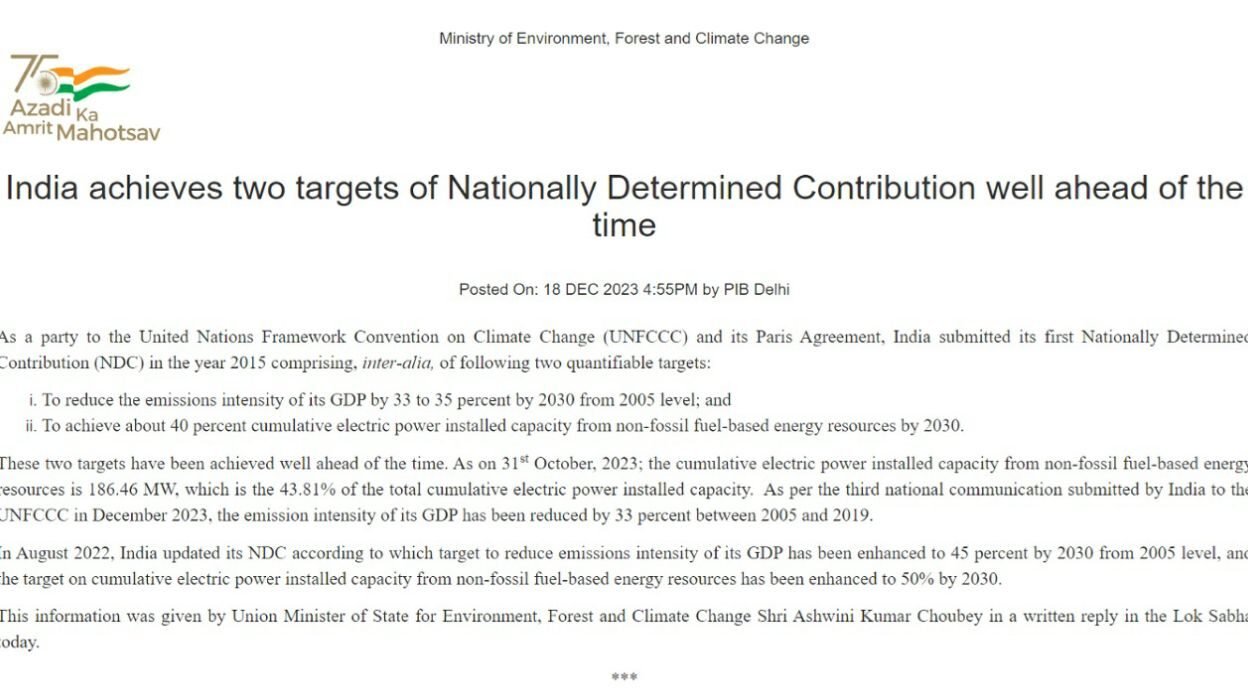Paris Climate Agreement: What You Need to Know
Is the Paris Agreement at Stake?
World Meteorological Organisation (WMO) reports warn that annual average global temperature will exceed 1.5°C above pre-industrial levels in the next five years.
Background
The Paris Agreement is the product of UNFCCC (United Framework Convention of Climate Change). It is a legally binding agreement under the United Nations Framework Convention on Climate Change (UNFCCC). It was adopted during the COP 21 (21st Conference of Parties) of UNFCCC in Paris, France, on 12 December 2015. The UNFCCC has led to the adoption of numerous agreements, including the Kyoto Protocol (1997).
The Paris Agreement was enforced on 4th November 2016 after ratification by 55 countries of 198 parties of UNFCCC. At present, 195 parties of the UNFCCC have ratified the Paris Agreement.
The Paris Agreement, a global response to keep the global average temperature rise below 2 degrees Celsius above the pre-industrial levels and to pursue efforts to keep the temperature from exceeding 2 degrees Celsius above the pre-industrial level.
Pre-industrial levels: The global atmosphere before the beginning of adverse impacts of industrialisation (mid-18th and early 19th centuries)

What is UNFCCC?
- UNFCCC, a product of the Earth Summit, 1992, aims to stabilise the greenhouse gas concentrations in the atmosphere.
- It was enforced on March 21, 1994. Its first conference of party (COP 1) was held in Berlin, Germany, in 1995. The recent COP 29 was held in Baku, Azerbaijan, in 2024.
Implementation of the Paris Agreement
- The Paris Agreement is based on a 5-year cycle approach where every 5 years, countries revisit and upgrade their commitment for the next cycle.
- For this purpose, all parties of the Paris Agreement need to submit their national action plan on climate change, known as nationally determined contributions (NDCs).
India’s Updated Nationally Determined Contribution Under the Paris Agreement:
- India submitted its first Nationally Determined Contribution (NDC) on October 2, 2015, for the period up to 2030. In August 2022, India updated its first Nationally Determined Contribution (NDC), which is given below:
- To achieve about 50 % cumulative electric power installed capacity by 2030 from non-fossil fuel-based energy resources.
- To create an additional carbon sink of 2.5 to 3 billion tonnes of CO2 equivalent by 2030.
- These updates will accelerate our long-term goal of reaching net-zero by 2070.

Preparing for the UGC NET exam can be a daunting task, but with the right resources, candidates can navigate the process effectively. Websites like MyJRF provide a comprehensive platform for aspiring educators, offering specialized guidance for UGC NET Paper 2 preparation and essential tips for acing UGC NET Paper 1. Additionally, understanding the revised syllabus provided by UGC is crucial for a targeted study approach. For official announcements and updates, candidates should regularly visit the UGC NET NTA portal, while the UGC’s job section and the main UGC website are invaluable for post-exam opportunities and academic resources. With these tools, candidates can maximize their preparation and set themselves up for success.
FAQs on the Paris Climate Agreement:
1. What is the Paris Climate Agreement?
Answer:
The Paris Climate Agreement is a landmark international treaty adopted in December 2015 under the United Nations Framework Convention on Climate Change (UNFCCC). Its primary goal is to combat climate change by limiting global warming to well below 2°C above pre-industrial levels, with an aspirational target of limiting the increase to 1.5°C. The agreement unites nearly every country in the world in a collective effort to reduce greenhouse gas emissions, enhance climate resilience, and mobilise financial resources to support climate action, especially in developing nations. Unlike previous agreements, the Paris Agreement employs a bottom-up approach where each country sets its own targets, known as Nationally Determined Contributions (NDCs), and regularly updates them to increase ambition over time.
2. Which countries are part of the Paris Climate Agreement?
Answer:
As of 2024, nearly 200 countries have ratified or acceded to the Paris Climate Agreement, making it one of the most universally supported international treaties. This includes major emitters such as the United States, China, the European Union member states, India, and many others. The widespread participation signifies a global consensus on the importance of addressing climate change. However, participation can vary in terms of commitment levels and the specific targets set by each country. The agreement also allows for non-state actors, including cities, businesses, and organisations, to contribute to its objectives, further broadening its reach and impact.
3. What are Nationally Determined Contributions (NDCs)?
Answer:
Nationally Determined Contributions (NDCs) are at the heart of the Paris Agreement. Each participating country is required to outline and communicate its plans to reduce national emissions and adapt to the impacts of climate change. These contributions are determined by the individual countries, reflecting their specific circumstances, capabilities, and development priorities. NDCs typically include targets for reducing greenhouse gas emissions, strategies for achieving these targets, and measures for enhancing resilience against climate impacts. Countries are expected to update their NDCs every five years, with each new submission representing a progression beyond previous efforts, thereby increasing the overall ambition to meet the agreement’s long-term goals.
4. How does the Paris Agreement aim to limit global warming to 1.5°C?
Answer:
Limiting global warming to 1.5°C involves a combination of strategies outlined in the Paris Agreement. Key approaches include:
- Emission Reductions: Countries commit to significant cuts in greenhouse gas emissions through transitioning to renewable energy, improving energy efficiency, and adopting low-carbon technologies.
- Carbon Pricing: Implementing mechanisms like carbon taxes or cap-and-trade systems to incentivise reductions in emissions.
- Climate Finance: Mobilising financial resources to support mitigation and adaptation efforts, particularly in developing countries.
- Adaptation Strategies: Enhancing resilience to climate impacts by investing in infrastructure, disaster preparedness, and sustainable agriculture.
- Technological Innovation: Promoting research and development of new technologies that can reduce emissions and support sustainable practices.
- Global Cooperation: Facilitating collaboration between countries to share knowledge, technology, and best practices.
Achieving the 1.5°C target requires rapid and unprecedented changes across all sectors of the global economy, driven by both policy measures and individual actions.
5. What mechanisms are in place to ensure countries comply with their commitments?
Answer:
The Paris Agreement employs several mechanisms to promote compliance and accountability among its signatories:
- Transparency Framework: Countries must regularly report on their emissions and progress toward their NDCs. These reports are subject to technical expert reviews to ensure accuracy and completeness.
- Global Stocktake: Every five years, starting in 2023, there is a comprehensive assessment of collective progress toward the agreement’s goals. This process informs countries in updating and enhancing their NDCs.
- Peer Pressure and Naming: The agreement relies on a system of transparency and global peer pressure to encourage countries to meet their commitments. While there are no strict enforcement penalties, the public nature of reporting fosters accountability.
- Facilitative and Supportive Environment: The agreement provides support through capacity-building and financial assistance, especially for developing countries, to help them meet their targets.
- Voluntary Cooperation: Countries can engage in cooperative approaches, such as carbon trading, to achieve their emissions targets more efficiently.
While the Paris Agreement does not impose punitive measures for non-compliance, the combination of transparency, global scrutiny, and the requirement to enhance commitments over time creates a robust framework for ensuring that countries strive to fulfil their climate pledges.
6. How does the Paris Agreement address climate finance?
Answer:
Climate finance is a critical component of the Paris Agreement, ensuring that developing countries have the necessary resources to implement their mitigation and adaptation strategies. Key aspects include:
- Financial Commitments: Developed countries pledged to mobilise $100 billion per year by 2020 to support climate action in developing nations. Efforts have been made to continue and scale up this funding beyond 2020.
- Green Climate Fund (GCF): The GCF is a central mechanism for channelling financial resources from developed to developing countries, supporting projects that reduce emissions and enhance resilience.
- Private Sector Engagement: The agreement encourages the involvement of private investors in climate finance through incentives, risk mitigation, and creating favourable investment environments.
- Innovative Financing Solutions: Developing new financial instruments, such as green bonds and climate insurance, to address funding gaps and support sustainable development.
- Transparency and Accountability: Ensuring that financial flows are tracked and reported transparently to maintain trust and demonstrate the effective use of funds.
By prioritising climate finance, the Paris Agreement aims to bridge the funding gap, enabling all countries, particularly those with limited resources, to take meaningful climate action.
7. What are the main challenges in achieving the goals of the Paris Agreement?
Answer:
Several significant challenges hinder the realisation of the Paris Agreement’s objectives:
- Insufficient Ambition: Current NDCs are not yet aligned with the 1.5°C target, requiring much more aggressive emission reductions.
- Political and Economic Factors: Changes in political leadership and economic priorities can lead to fluctuating commitment levels, as seen with the United States’ temporary withdrawal and subsequent rejoining.
- Financial Constraints: Mobilising the necessary climate finance, especially for developing countries, remains a persistent challenge.
- Technological Barriers: Developing and deploying the required low-carbon technologies at scale is essential but can be hindered by technical, financial, and infrastructural limitations.
- Equity and Fairness: Balancing the responsibilities and capabilities of developed and developing nations, ensuring that actions are perceived as fair and just.
- Implementation and Enforcement: The voluntary nature of the agreement relies heavily on national will and global cooperation, which can be inconsistent.
- Public Awareness and Support: Achieving broad-based support for climate policies is crucial but can be difficult due to misinformation, competing interests, and varying levels of public engagement.
Addressing these challenges requires sustained global cooperation, increased ambition, innovative solutions, and robust support mechanisms to ensure that all countries can contribute effectively to the common goal of mitigating climate change.
8. What progress has been made since the Paris Agreement was adopted?
Answer:
Since its adoption in 2015, the Paris Agreement has spurred significant global climate action, though progress has been mixed:
- Emission Reductions: Many countries have implemented policies to reduce emissions, leading to a gradual decoupling of economic growth from carbon emissions in some regions.
- Renewable Energy Expansion: There has been substantial growth in renewable energy capacity, particularly in solar and wind power, driven by falling costs and supportive policies.
- Climate Finance: Financial commitments have continued, with increased investments in climate mitigation and adaptation projects, though gaps remain, especially for the most vulnerable countries.
- Technological Advancements: Innovations in clean technologies, energy storage, and carbon capture and storage (CCS) have advanced, contributing to lower emissions.
- Global Stocktake: Regular assessments have provided valuable insights into collective progress, highlighting areas needing increased ambition and action.
- Enhanced National Commitments: Many countries have updated their NDCs to reflect higher targets and more comprehensive climate strategies.
- Public and Private Sector Engagement: There has been growing involvement from businesses, cities, and civil society organisations, fostering a multi-stakeholder approach to climate action.
Despite these achievements, global emissions continue to rise, and the current trajectory is insufficient to meet the Paris Agreement’s targets. This underscores the need for enhanced efforts, greater ambition, and accelerated implementation to ensure that the goals of the agreement are achieved in the coming years.





